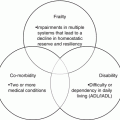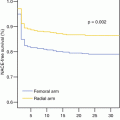Letter
Clinical characteristic
Points
H
Hypertension
1
A
Abnormal renal and liver enzymes (1 point each)
1–2
S
Stroke
1
B
Bleeding
1
L
Labile INRs
1
E
Elderly (e.g. age >65 years)
1
D
Drugs or alcohol (1 point each)
1–2
Maximum score
9
Letter | Clinical characteristic | Points |
|---|---|---|
C | Congestive heart failure/left ventricular dysfunction | 1 |
H | Hypertension | 1 |
A 2 | Age ≥ 75 years | 2 |
D | Diabetes | 1 |
S2 | Stroke/TIA/thromboembolism | 2 |
V | Vascular disease (prior myocardial Infarction; peripheral artery disease) | 1 |
A | Age 65–74 years | 1 |
Sc | Sex category (female) | 1 |
Maximum score | 9 | |
Current standard guidelines recommend DAPT for a time span from 4 weeks in patients undergoing elective stenting using bare metal stents (BMS) up to 12 months in patients with drug eluting stents (DES) and/or patients undergoing coronary stenting for acute coronary syndrome [1]. These recommendations do not adequately apply to patients with enhanced bleeding risk or patients with indication for additional oral anticoagulation in whom the recommended duration of DAPT ranges from 2–4 weeks to 12 months depending on the individual risk profile [4, 7]. Specific procedural aspects (suboptimal result, bifurcational stenting) that may hinder a complete endothelialization of the stent may even legitimate a prolonged DAPT >1 year in individual patients [7]. The emerging diversity of next generation stent platforms (e.g., bioabsorbable scaffolds) further contributes to the need of a more and more individualized decision process.
Age plays an essential role for the final decision of how to treat the individual patient after PCI. Elderly patients carry an increased risk of bleeding when taking anticoagulation or antiplatelet therapy or even a combination of both (Table 10.1). Factors that may account for the enhanced bleeding risk are the higher incidence of comorbidities, frailty, low body weight, and the increased need for unplanned non-cardiac surgery.
The choice of the antithrombotic therapy in elderly patients remains an ongoing challenge, because they – besides enhanced risk for bleeding – often require an even more intensified antithrombotic therapy as compared to younger patients: First, elderly patients more often present with acute coronary syndromes requiring prolonged dual antiplatelet therapy. Second, the incidence of atrial fibrillation increases with age as does the risk of stroke in patients with atrial fibrillation [6], which can be calculated by the CHA2DS2Vasc Score (Table 10.1). Therefore, despite having an increased risk of bleeding, elderly patients undergoing coronary stent implantation often require an effective anticoagulation in combination with antiplatelet therapy [5, 7, 8].
Patients with Stable Coronary Artery Disease Without Recent PCI
Patients with symptomatic, stable coronary artery disease (CAD) are – irrespective of any prior PCI – advised to take antiplatelet monotherapy. This recommendation is based on data from multiple large trials performed in the 1980s and 1990s, e.g., a metaanalysis of the so-called antithrombotic trialist’s collaboration. This trial proved the superiority of antiplatelet therapy versus placebo in patients with symptomatic coronary artery disease regarding the incidence of stroke, myocardial infarction or death [9]. The CAPRIE Trial has additionally compared the treatment of aspirin (325 mg/day) with clopidogrel (75 mg/day) in 19,185 patients with symptomatic atherothrombotic disease history of stroke, myocardial infarction or symptomatic peripheral artery disease [10]. This trial showed the non-inferiority of clopidogrel, which may serve as an alternative to aspirin in these patients. In fact, CAPRIE even showed a benefit for clopidogrel in the subgroup of patients with peripheral arterial disease regarding the incidence of ischemic stroke, myocardial infarction or vascular death. However, dual antiplatelet therapy (DAPT) did not show a clinical benefit over antiplatelet monotherapy in clinically stable patients: CHARISMA studied the potential benefit of a combined dual antiplatelet therapy using low-dose aspirin (75 mg/day) plus clopdogrel (75 mg/day) versus aspirin monotherapy in 15,603 patients with symptomatic cardiovascular disease or with multiple risk factors and followed them over a period of 28 months (median). CHARISMA did not show any additional benefit for dual antiplatelet therapy regarding the incidence of ischemic events, however, a trend of enhanced bleeding events with dual therapy [11].
Together, the current recommendation for patients with symptomatic stable coronary disease (without recent PCI) is a lifelong antiplatelet monotherapy using aspirin (75–125 mg/day) or – as an alternative – clopidogrel (75 mg/day) irrespective of any additional risk factors [1].
Patients with Coronary Stent Implantation in Stable Angina
Stent thrombosis is the most severe complication, and, therefore, is the Achilles’heel of coronary stent implantation. In patients with coronary stent implantation, dual antiplatelet therapy using acetylsalicylic acid (ASA, aspirin) and an ADP receptor antagonist (e.g., clopidogrel) is the current standard strategy to prevent stent thrombosis.
DAPT Initiation and “Loading dose”
Since clopidogrel is a “pro-drug”, which requires metabolization in the liver, clopidogrel should be administered prior to the intervention. Depending on the time interval from the intake of the “loading dose” to the planned coronary intervention, it is currently recommended to use a loading dose of at least 300 (>12 h prior to PCI) or 600 mg (<3 h) prior to a planned PCI [1]. The best time point of administration of clopidogrel is currently a matter of debate. In patients undergoing coronary angiography for stable angina it is recommended to start clopidogrel “loading” after the diagnostic angiography on the table immediately prior to PCI. Besides clopidogrel dual antiplatelet therapy also includes a 150–300 mg oral loading dose of ASA (or 80–150 mg i.v.).
DAPT Dosage and Duration
ASA is recommended to be taken life-long by 75–100 mg per os daily, the recommended dosage of clopidogrel is 75 mg daily [12–14].
The recommended duration of DAPT is a matter of an ongoing debate. It depends on several conditions, e.g., stent type (bare metal or drug-eluting stent), the individual angiographic result, clinical condition (elective stenting versus stenting in ACS), as well as additional individual patient characteristics (e.g., age, history of bleeding).
DAPT is recommended for at least 1 month after BMS implantation and for 6 months after DES implantation by the European Society of Cardiology [1]. Having the second and third generation DES available the risk of stent thrombosis has been further reduced in the meantime. Recently, it has been shown that a period of 3 months of DAPT may be sufficient in selected patients with selected next generation DES [15, 16].
Nevertheless, the development and clinical application of novel stent or “scaffold” designs using novel bioresorbable materials requires additional clinical experience and investigations.
Accordingly, the ESC recommends to make the decision on the respective duration of DAPT after DES implantation on an individual basis: One may consider a shorter DAPT duration (<6 months) after DES implantation in patients at high bleeding risk and a longer duration (>6 months) in patients at high ischaemic and low bleeding risk (class IIb recommendation) [1]. In elderly patients these considerations need to be taken into account.
Patients with Coronary Stent Implantation in Acute Coronary Syndromes
Stay updated, free articles. Join our Telegram channel

Full access? Get Clinical Tree







